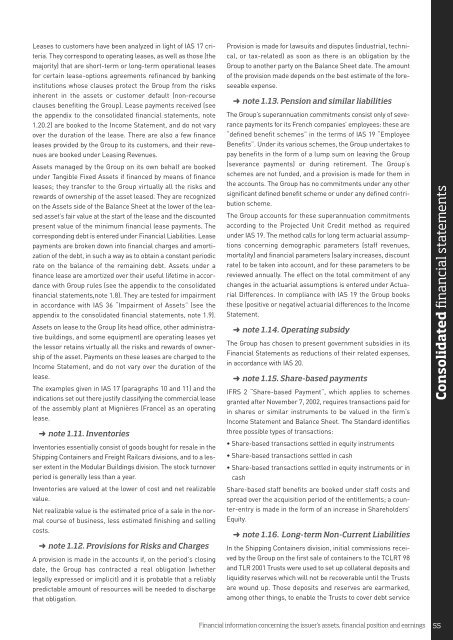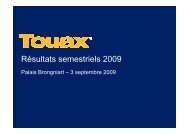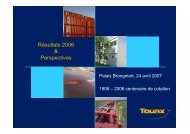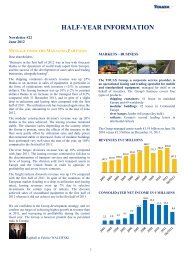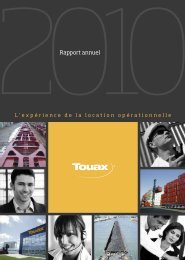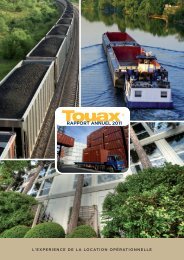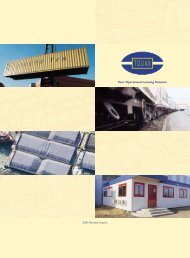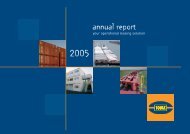2010 annual report - touax group
2010 annual report - touax group
2010 annual report - touax group
Create successful ePaper yourself
Turn your PDF publications into a flip-book with our unique Google optimized e-Paper software.
Leases to customers have been analyzed in light of IAS 17 criteria.<br />
They correspond to operating leases, as well as those (the<br />
majority) that are short-term or long-term operational leases<br />
for certain lease-options agreements refinanced by banking<br />
institutions whose clauses protect the Group from the risks<br />
inherent in the assets or customer default (non-recourse<br />
clauses benefiting the Group). Lease payments received (see<br />
the appendix to the consolidated financial statements, note<br />
1.20.2) are booked to the Income Statement, and do not vary<br />
over the duration of the lease. There are also a few finance<br />
leases provided by the Group to its customers, and their revenues<br />
are booked under Leasing Revenues.<br />
Assets managed by the Group on its own behalf are booked<br />
under Tangible Fixed Assets if financed by means of finance<br />
leases; they transfer to the Group virtually all the risks and<br />
rewards of ownership of the asset leased. They are recognized<br />
on the Assets side of the Balance Sheet at the lower of the leased<br />
asset’s fair value at the start of the lease and the discounted<br />
present value of the minimum financial lease payments. The<br />
corresponding debt is entered under Financial Liabilities. Lease<br />
payments are broken down into financial charges and amortization<br />
of the debt, in such a way as to obtain a constant periodic<br />
rate on the balance of the remaining debt. Assets under a<br />
finance lease are amortized over their useful lifetime in accordance<br />
with Group rules (see the appendix to the consolidated<br />
financial statements,note 1.8). They are tested for impairment<br />
in accordance with IAS 36 “Impairment of Assets” (see the<br />
appendix to the consolidated financial statements, note 1.9).<br />
Assets on lease to the Group (its head office, other administrative<br />
buildings, and some equipment) are operating leases yet<br />
the lessor retains virtually all the risks and rewards of ownership<br />
of the asset. Payments on these leases are charged to the<br />
Income Statement, and do not vary over the duration of the<br />
lease.<br />
The examples given in IAS 17 (paragraphs 10 and 11) and the<br />
indications set out there justify classifying the commercial lease<br />
of the assembly plant at Mignières (France) as an operating<br />
lease.<br />
➜ note 1.11. Inventories<br />
Inventories essentially consist of goods bought for resale in the<br />
Shipping Containers and Freight Railcars divisions, and to a lesser<br />
extent in the Modular Buildings division. The stock turnover<br />
period is generally less than a year.<br />
Inventories are valued at the lower of cost and net realizable<br />
value.<br />
Net realizable value is the estimated price of a sale in the normal<br />
course of business, less estimated finishing and selling<br />
costs.<br />
➜ note 1.12. Provisions for Risks and Charges<br />
A provision is made in the accounts if, on the period's closing<br />
date, the Group has contracted a real obligation (whether<br />
legally expressed or implicit) and it is probable that a reliably<br />
predictable amount of resources will be needed to discharge<br />
that obligation.<br />
Provision is made for lawsuits and disputes (industrial, technical,<br />
or tax-related) as soon as there is an obligation by the<br />
Group to another party on the Balance Sheet date. The amount<br />
of the provision made depends on the best estimate of the foreseeable<br />
expense.<br />
➜ note 1.13. Pension and similar liabilities<br />
The Group’s superannuation commitments consist only of severance<br />
payments for its French companies’ employees: these are<br />
“defined benefit schemes” in the terms of IAS 19 “Employee<br />
Benefits”. Under its various schemes, the Group undertakes to<br />
pay benefits in the form of a lump sum on leaving the Group<br />
(severance payments) or during retirement. The Group’s<br />
schemes are not funded, and a provision is made for them in<br />
the accounts. The Group has no commitments under any other<br />
significant defined benefit scheme or under any defined contribution<br />
scheme.<br />
The Group accounts for these superannuation commitments<br />
according to the Projected Unit Credit method as required<br />
under IAS 19. The method calls for long term actuarial assumptions<br />
concerning demographic parameters (staff revenues,<br />
mortality) and financial parameters (salary increases, discount<br />
rate) to be taken into account, and for these parameters to be<br />
reviewed <strong>annual</strong>ly. The effect on the total commitment of any<br />
changes in the actuarial assumptions is entered under Actuarial<br />
Differences. In compliance with IAS 19 the Group books<br />
these (positive or negative) actuarial differences to the Income<br />
Statement.<br />
➜ note 1.14. Operating subsidy<br />
The Group has chosen to present government subsidies in its<br />
Financial Statements as reductions of their related expenses,<br />
in accordance with IAS 20.<br />
➜ note 1.15. Share-based payments<br />
IFRS 2 “Share-based Payment”, which applies to schemes<br />
granted after November 7, 2002, requires transactions paid for<br />
in shares or similar instruments to be valued in the firm’s<br />
Income Statement and Balance Sheet. The Standard identifies<br />
three possible types of transactions:<br />
• Share-based transactions settled in equity instruments<br />
• Share-based transactions settled in cash<br />
• Share-based transactions settled in equity instruments or in<br />
cash<br />
Share-based staff benefits are booked under staff costs and<br />
spread over the acquisition period of the entitlements; a counter-entry<br />
is made in the form of an increase in Shareholders’<br />
Equity.<br />
➜ note 1.16. Long-term Non-Current Liabilities<br />
In the Shipping Containers division, initial commissions received<br />
by the Group on the first sale of containers to the TCLRT 98<br />
and TLR 2001 Trusts were used to set up collateral deposits and<br />
liquidity reserves which will not be recoverable until the Trusts<br />
are wound up. Those deposits and reserves are earmarked,<br />
among other things, to enable the Trusts to cover debt service<br />
Consolidated financial statements<br />
Financial information concerning the issuer’s assets, financial position and earnings I 55


